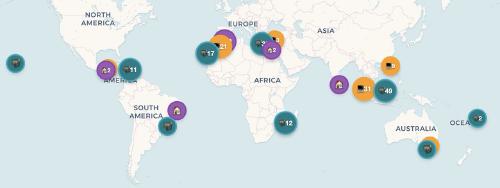Organizational Tension Processing – Driving Change in Self-Organizing Companies
Newcomers to self-organization often mistake the lack of a people-hierarchy for complete chaos. The term “flat” can be misleading, as it suggests that self-organizing companies lack any structure. In reality, this is far from the case.
Traditional companies typically rely on strict hierarchies to make up for missing suitable processes and structures. This usually leads to a lack of flexibility, causing the organization to become ineffective over time. In contrast, self-organizing companies have a “flat” structure, in the sense that no one person has total control over another’s future. However, they still need to adjust their structures, processes, and goals quickly and effectively.
In this article, I will write about how this can be done through a tension-based proposal process, that I have seen in effect in companies in person myself. I also know that many companies following Holacracy have established similar processes.
The “Problem Statement”
In most organizations, we have astonishing people with diverse backgrounds, experiences, and ideas. Those people work in different areas of the organization on different topics and in relationship with different people. Everybody can provide a unique perspective and can see things others can’t.
We don’t want to miss great ideas, whether they relate to product development or improving our work methods and organization. It’s essential to find ways to share and implement these ideas, regardless of where they come from. Traditional hierarchical companies often struggle with this, as good ideas at lower levels must first climb to the C-level before they can be considered. This means many companies miss out on the valuable insights their employees have about challenges and potential solutions. Additionally, they frequently face difficulties in implementing change, as changes are usually imposed from the top without buy-in from those impacted. Good news: All of this can be solved.
In addition to struggling to bring attention to issues, companies also need to make decisions quickly to adapt to changes and new information. However, long communication routes and a fear of making decisions in many organizations hinder their ability to respond effectively to changing circumstances.
Apart from the inability of driving change quickly, we also want to avoid cargo cult (“Let’s use the Spotify model”). Every company is different, and it is highly unlikely that something working somewhere else will just work in the same way for your context (side note: Even Spotify isn’t using the Spotify Model). To solve this, we must ensure that we are not just changing for the sake of change and because others do it, but because we sense a tension with our current way of doing things.
“Tension,” as used in Holacracy, is a neutral term that simply means the feeling of a specific gap between current reality and a sensed potential – Brian J. Robertson in “Holacracy”
Tensions are beneficial because they indicate that something could be improved. They signal that change might be necessary. Unfortunately, in many organizations, people lack the tools or processes to transform these tensions into constructive actions. As a result, humans internalize these tensions, leading to frustration, apathy, or burnout.
How a Tension-based Proposal Process Solves this
First and foremost, a tension-based proposal process gives everyone a tool to express their tension around something within the organization (a process, a structure, a cultural aspect, …). This amplifies that something potentially prevents the company from functioning in the best possible way.
Second, it gives the person sensing the tension a way to propose a solution and make some risk analysis (Can the proposed change cause damage? Can the change be reversed? Is the cost of the change bigger than the cost of doing nothing? …)
Third, it allows everybody in the company to understand the tension, even if they have not experienced it. It also enables everybody to ask clarifying questions about the tension and the proposed solution.
Fourth, it allows people to object if they believe the proposed solution causes damage. Objection ≠ “I don’t like it.” — Objection = “This will harm us and here is why: …”
The point of the process is to enable continuous improvement. — One tension at a time. If done correctly, this increases people’s willingness to try a change even if they don’t think it is the best solution, as they can always raise another tensions, as soon as they experience it.
Finally, change is not always needed to resolve a tension. Just by framing and raising a tension and by sharing it with others, we might receive more information that can lead to a resolution.
An extremely nice side effect of this process is that tensions and their solutions are documented, and people later can understand why the company works the way it does.
How the Process Works
When people feel a tension, they start by writing it down. They might choose to first discuss it with a trusted person or a caring circle to better understand it and find the right change to propose. A good practice is to involve people that will be affected by the change in the caring circle. This helps to hear different ideas early on and incorporate them into a proposed solution.
Through the writing, the tension-feeling person can understand and frame their tension better. Furthermore, the written tension gives others the context needed to understand and judge the proposal. They can then write down the suggested change as a proposal. They can also think through potential risks and mitigations. A good proposal also answers the following questions:
- Could it do harm?
- Is it reversible?
- What is the cost of doing nothing? What is the cost of the change?
- What risks exist, and how can those be mitigated?
Once the proposal is ready, it is shared with the organization or group impacted by the proposal. People are given an appropriate amount of time to read the proposal and react to it. People can ask understanding questions and bring up aspects the proposer might not have considered. The proposer can then improve the proposal.
If people already raise objections, those can be discussed and integrated into the proposal. If an objection is valid, it might lead to a change of the proposal to resolve the objection.
Finally, the proposer sets a date at which the proposal will become effective (default-to-yes) unless an objection comes up. If people do not have any objections, the proposal will become effective and everybody starts working according to the proposed change.
How to Introduce the Process and Make it Stick
As with every change, it is important to help people understand the “Why” behind it. Again: What is the tension addressed by introducing this new process?
Introduce the process, show the benefits and give examples. Lead by example and use the process for organizational changes of all kind.
Avoid top-down decision-making in the traditional way, as this will confuse people about when the tension-based process can be used and which decision-making freedoms they have. Trust the process. You can always raise an objection if you see a potentially harmful change.
Make sure to read proposals and provide feedback. Ensure that only real objections prevent a proposal from going through.
Coach people with tensions. Do not solve their problems or write a proposal for them but encourage and coach them to process their tensions using the new process.
Implement a centralized digital platform (like Notion) where employees can log and process their tensions. This log should be accessible to all, allowing for transparency and collective awareness. Create a standardized template for proposals that includes sections for describing the tension, proposed solutions, risk analysis, and feedback.
Include training on the tension processing process as part of the onboarding program for new employees. This will help instill the importance of this practice from the beginning.
Define and communicate the channels through which employees can raise tensions and receive updates on proposals. Ensure that these channels are user-friendly and accessible.
Common Pitfalls (How to make this fail)
- Seeking consensus: A frequent mistake in any change process is trying to achieve consensus. This approach can be inefficient, frustrating, and sometimes unfeasible. People don’t have to agree with the proposed change, but unless they have a valid objection, they should accept it. After all, the tension being addressed isn’t theirs. If they feel a tension after the change, they can always create a new proposal.
- Resorting to old habits: If decisions are made using the traditional top-down approach, it will confuse people and erode their trust in the new system. It will be unclear which decisions come from the top and which follow the tension-based process. Leaders should also address their tensions through the proposal process, just like everyone else.
- Overcomplicating the process: If the tension processing steps are too complex or bureaucratic, employees may become discouraged from participating. Ensure that the process is straightforward and user-friendly.
- Inadequate follow-up: Failing to follow up on tensions or proposals can lead to frustration and disengagement. It’s essential to communicate outcomes and next steps clearly after a proposal is discussed.
- Neglecting context: Failing to consider the specific context of the organization when processing tensions can lead to inappropriate or ineffective solutions. Encourage context-sensitive discussions.
Conclusion
Adopting a tension-based proposal process needs time and continuous reinforcement. But once people got used to this process, it is the most liberating, fair, and efficient approach to organizational tension processing I know.
It gives everybody a voice and the ability to drive organizational change, and thus enables every human to co-create an organization that serves its purpose in the best possible way.
If you have questions about this topic or how to implement such a process in your organization, I invite you to schedule a free call with me to discuss this further.





Use the share button below if you liked it.
It makes me smile, when I see it.